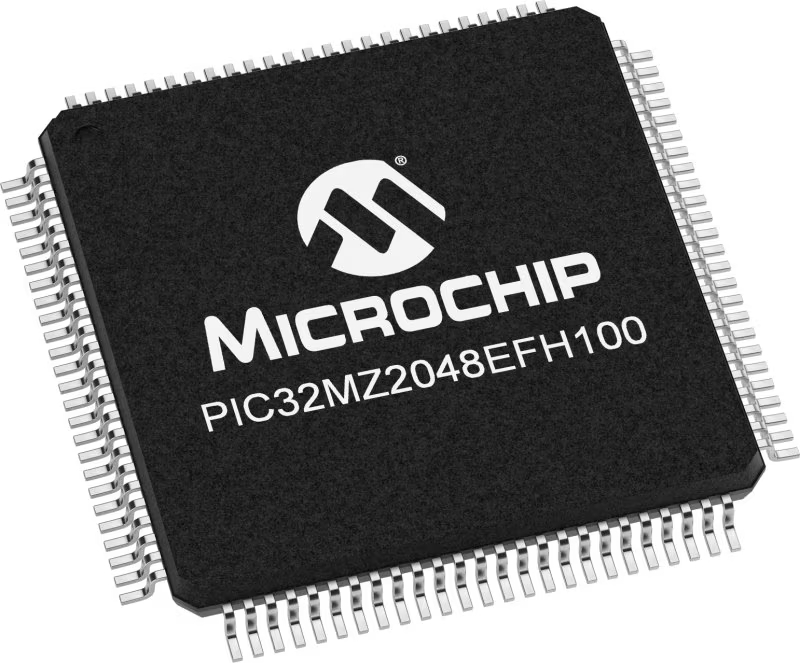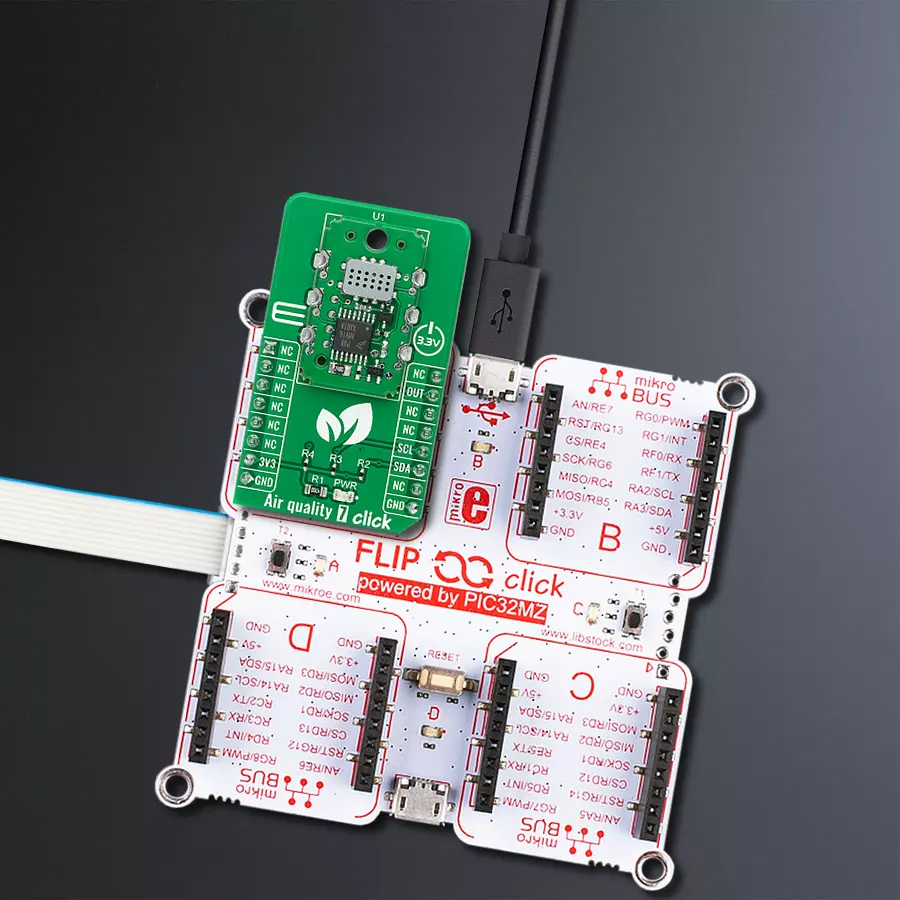Our comprehensive air quality monitoring solution empowers individuals, businesses, and communities with accurate data to make informed decisions for healthier surroundings.
A
A
Hardware Overview
How does it work?
Air Quality 7 Click is based on the MiCS-VZ-89TE, an integrated sensor module from Amphenol for indoor air quality monitoring. The MiCS-VZ-89TE combines the most modern MOS sensor technology with intelligent detection algorithms to control VOCs and CO2 fluctuations in buildings. Among other appealing features like 3.3V supply, I2C communication, and calibration-free high sensitivity, this module has a small size factor. The sensor must not be exposed to high concentrations of organic solvents, ammonia, silicone vapor, or cigarette smoke to avoid poisoning the sensitive layer. It should be protected against water and dust projections, and its Vendor strongly recommends using ESD protection equipment to handle the sensor. This Click board™ is easy to program and read data because it does not require an overly demanding configuration. The first step is the initialization of
all the necessary peripherals and pins. The additional delay time of a couple of seconds during system initialization is needed because this Click board™ needs some time to establish the measurements. The second initialization is the I2C driver and communication test by reading the revision information of the module. If the CRC check is OK, it allows the program to go on; if it's not, a user needs to restart the program. The user can read the air quality status if every step is valid. This can also be seen in an example code that contains easy-to-use functions that may be used as a reference for further development. Air quality 7 Click communicates with MCU using the standard I2C 2-Wire interface that supports Standard-Mode operation with bit rates up to 100 kbit/s. The MiCS-VZ-89TE slave address contains seven fixed bits. The slave address byte is the first byte received following the START condition from
the host device. The first part of the address byte consists of a 4-bit device code, which is set to 1110 for the IAQS, followed by three address bits (A2, A1, A0), which are programmed at 0. The dual signal output routed on the OUT pin of the mikroBUS™ socket, which brings the results of the measurements, can be read through a multiplexed PWM output or an I2C bus. This Click board™ is designed to be operated only with a 3.3V logic voltage level. A proper logic voltage level conversion should be performed before the Click board™ is used with MCUs with different logic voltage levels. More information about the MiCS-VZ-89TE can be found in the attached datasheet. However, the Click board™ comes equipped with a library that contains easy-to-use functions and a usage example that may be used as a reference for further development.
Features overview
Development board
Flip&Click PIC32MZ is a compact development board designed as a complete solution that brings the flexibility of add-on Click boards™ to your favorite microcontroller, making it a perfect starter kit for implementing your ideas. It comes with an onboard 32-bit PIC32MZ microcontroller, the PIC32MZ2048EFH100 from Microchip, four mikroBUS™ sockets for Click board™ connectivity, two USB connectors, LED indicators, buttons, debugger/programmer connectors, and two headers compatible with Arduino-UNO pinout. Thanks to innovative manufacturing technology,
it allows you to build gadgets with unique functionalities and features quickly. Each part of the Flip&Click PIC32MZ development kit contains the components necessary for the most efficient operation of the same board. In addition, there is the possibility of choosing the Flip&Click PIC32MZ programming method, using the chipKIT bootloader (Arduino-style development environment) or our USB HID bootloader using mikroC, mikroBasic, and mikroPascal for PIC32. This kit includes a clean and regulated power supply block through the USB Type-C (USB-C) connector. All communication
methods that mikroBUS™ itself supports are on this board, including the well-established mikroBUS™ socket, user-configurable buttons, and LED indicators. Flip&Click PIC32MZ development kit allows you to create a new application in minutes. Natively supported by Mikroe software tools, it covers many aspects of prototyping thanks to a considerable number of different Click boards™ (over a thousand boards), the number of which is growing every day.
Microcontroller Overview
MCU Card / MCU

Architecture
PIC32
MCU Memory (KB)
2048
Silicon Vendor
Microchip
Pin count
100
RAM (Bytes)
524288
Used MCU Pins
mikroBUS™ mapper
Take a closer look
Click board™ Schematic

Step by step
Project assembly
Track your results in real time
Application Output
1. Application Output - In Debug mode, the 'Application Output' window enables real-time data monitoring, offering direct insight into execution results. Ensure proper data display by configuring the environment correctly using the provided tutorial.

2. UART Terminal - Use the UART Terminal to monitor data transmission via a USB to UART converter, allowing direct communication between the Click board™ and your development system. Configure the baud rate and other serial settings according to your project's requirements to ensure proper functionality. For step-by-step setup instructions, refer to the provided tutorial.

3. Plot Output - The Plot feature offers a powerful way to visualize real-time sensor data, enabling trend analysis, debugging, and comparison of multiple data points. To set it up correctly, follow the provided tutorial, which includes a step-by-step example of using the Plot feature to display Click board™ readings. To use the Plot feature in your code, use the function: plot(*insert_graph_name*, variable_name);. This is a general format, and it is up to the user to replace 'insert_graph_name' with the actual graph name and 'variable_name' with the parameter to be displayed.

Software Support
Library Description
This library contains API for Air Quality 7 Click driver.
Key functions:
airquality7_get_status- Get Status functionairquality7_get_revision- Get Revision functionairquality7_get_r0_calib- Get R0 Calibration function.
Open Source
Code example
The complete application code and a ready-to-use project are available through the NECTO Studio Package Manager for direct installation in the NECTO Studio. The application code can also be found on the MIKROE GitHub account.
/*!
* \file
* \brief AirQuality7 Click example
*
* # Description
* This demo application measures air quality.
*
* The demo application is composed of two sections :
*
* ## Application Init
* Initializes I2C driver and reads revision date of the module.
* If CRC check is OK allows the program to go on, otherwise, it displays a message that
* the program needs to be restarted.
*
* ## Application Task
* Reads air quality status every 1500ms and shows the results on the USB UART.
*
* \author MikroE Team
*
*/
// ------------------------------------------------------------------- INCLUDES
#include "board.h"
#include "log.h"
#include "airquality7.h"
// ------------------------------------------------------------------ VARIABLES
static airquality7_t airquality7;
static log_t logger;
uint16_t airquality7_tvoc_ppb;
uint16_t airquality7_co2_ppm;
uint32_t airquality7_res_val_ohm;
airquality7_err_t airquality7_err_code;
// ------------------------------------------------------ APPLICATION FUNCTIONS
void application_init ( void )
{
log_cfg_t log_cfg;
airquality7_cfg_t cfg;
uint8_t airquality7_rev_year = AIRQUALITY7_DUMMY;
uint8_t airquality7_rev_month = AIRQUALITY7_DUMMY;
uint8_t airquality7_rev_day = AIRQUALITY7_DUMMY;
uint8_t airquality7_rev_ascii_code = AIRQUALITY7_DUMMY;
/**
* Logger initialization.
* Default baud rate: 115200
* Default log level: LOG_LEVEL_DEBUG
* @note If USB_UART_RX and USB_UART_TX
* are defined as HAL_PIN_NC, you will
* need to define them manually for log to work.
* See @b LOG_MAP_USB_UART macro definition for detailed explanation.
*/
LOG_MAP_USB_UART( log_cfg );
log_init( &logger, &log_cfg );
log_info( &logger, "---- Application Init ----" );
// Click initialization.
airquality7_cfg_setup( &cfg );
AIRQUALITY7_MAP_MIKROBUS( cfg, MIKROBUS_1 );
airquality7_init( &airquality7, &cfg );
airquality7_tvoc_ppb = AIRQUALITY7_DUMMY;
airquality7_co2_ppm = AIRQUALITY7_DUMMY;
airquality7_res_val_ohm = AIRQUALITY7_DUMMY;
airquality7_err_code = airquality7_get_revision( &airquality7,
&airquality7_rev_year,
&airquality7_rev_month,
&airquality7_rev_day,
&airquality7_rev_ascii_code );
if ( airquality7_err_code == AIRQUALITY7_ERR_OK )
{
log_printf( &logger, " Revision date: %.2u.%.2u.%.2u\r\n", ( uint16_t ) airquality7_rev_day,
( uint16_t ) airquality7_rev_month,
( uint16_t ) airquality7_rev_year );
log_printf( &logger, " ASCII code for a charter: %u \r\n", ( uint16_t ) airquality7_rev_ascii_code );
}
else
{
log_printf( &logger, "CRC ERROR READING REVISION. \r\n" );
Delay_ms ( 1000 );
for ( ; ; )
{
log_printf( &logger, "PLEASE, RESTART YOUR SYSTEM...\r\n" );
Delay_ms ( 1000 );
log_printf( &logger, " \r\n \r\n " );
Delay_ms ( 1000 );
}
}
log_printf( &logger, "----------------------------------------- \r\n" );
Delay_ms ( 500 );
}
void application_task ( void )
{
airquality7_err_code = airquality7_get_status( &airquality7,
&airquality7_tvoc_ppb,
&airquality7_co2_ppm,
&airquality7_res_val_ohm,
AIRQUALITY7_NULL );
if ( airquality7_err_code == AIRQUALITY7_ERR_OK )
{
uint8_t cnt;
log_printf( &logger, " tVOC [ppb] = %u \r\n", airquality7_tvoc_ppb );
log_printf( &logger, " CO2 [ppm] = %u \r\n", airquality7_co2_ppm );
log_printf( &logger, " Resistor value [ohm] = %lu \r\n", airquality7_res_val_ohm );
log_printf( &logger, "----------------------------------------- \r\n" );
}
Delay_ms ( 1000 );
Delay_ms ( 500 );
}
int main ( void )
{
/* Do not remove this line or clock might not be set correctly. */
#ifdef PREINIT_SUPPORTED
preinit();
#endif
application_init( );
for ( ; ; )
{
application_task( );
}
return 0;
}
// ------------------------------------------------------------------------ END
Additional Support
Resources
Category:Gas
































